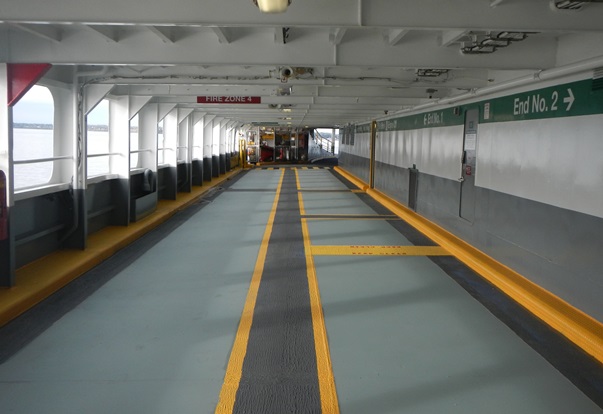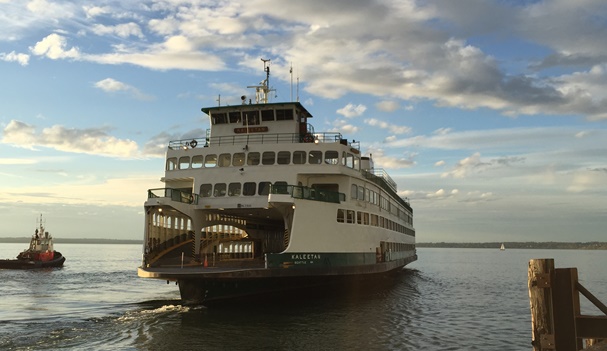As a scope, blasting and coating a car and passenger ferry might not sound like a challenging endeavor. But for Puglia Engineering, doing business as Fairhaven Shipyard with an 80- to 200-person yard, the details of the M/V Kaleetan project were complex.
The 382-feet long (116.5 m) project included coating work on railings, walls (called bulkheads), decks, and rescue boat “pockets.” The recoat was to be done on steel and aluminum substrates. There was electrical and steel work, including a variety of tests. They had to work 24 hours a day, 7 days a week, and they also had to overcome challenges with acquiring the amount of materials necessary. As if that wasn’t enough, they had exactly 92 days to complete the project.
“We’re a full-service shipyard,” said Dale Lockwood, senior project manager. They had the skills to complete the project, but could they overcome the choppy seas ahead?
Welcome Aboard
The M/V Kaleetan, which means “arrow” in Chinook, was originally built in San Diego in 1967. To bring it back to its former glory, the crew (averaging 100 to 125 people) started with prep. After establishing blast and paint zones, they protected all of the wiring from grit blasting and overspray. They zoned and sealed the area and then covered the wiring with ~10 miles (32.2 km) of rubber strips. Only once covered could the blasting crew come in to work.
Working in 100-foot-long (30.5 m) sections, Fairhaven Shipyard blasted to NACE No. 2/Society for Protective Coatings (SSPC) Surface Preparation (SP) 10: Near-White Blast Cleaning. They wore Nova 2000 blast hoods with fresh air and used four 8-ton (16,000 pound) blast kegs at 1,800 CFM (51.0 m³/min.). Each of the blast kegs had four hoses. On the steel substrates, they used 36-grit copper slag. To the aluminum substrates, which included part of the texas deck around the pilothouse and crew houses, the crew used 30/60 garnet from CESCO.
In areas where the blast hoses couldn’t reach, the 25-person blasting crew used power tools to achieve SSPC-SP-11: Power Tool Cleaning to Bare Metal. “After that, everything got cleaned up,” said Coatings Supervisor Benny Briones. They used vacuums from Vector Technologies for any spent slag or other debris and then sent the Quality Assurance (QA) team through.
“Along the way, we had lots of problems with electrical,” Lockwood said. “It was absolutely the most difficult blast job I’ve ever seen other than confined space…all those wire ways that interfere with you constantly while trying to blast.” To keep QA, an FME (Foreign Material Exclusion) team came in every four hours while the blasters were on break to inspect and repair any damaged wire protections.
“And then we’d roll into painting,” Briones said.
Full Steam Ahead
“One nice thing we did do at the beginning of this project is that we purchased a new Graco XL-70 pump,” said Briones. “We ran four lines off of that.” With four sprayers and 200 feet (61.0 m) of line for each, the paint crew applied 3‒4 mils (76.2‒101.6 microns) of Sherwin-Williams (SW) Corothane I Galva Pak green primer to the steel substrates. At night, the crew reached 12 people and by day they hit about 8 to complete touchups.
Once the primer was down, the crew covered the floors with paper; they’d be receiving a special anti-skid coating later. The coating systems also varied in type and color depending on the area of the ship.
The bulkheads and overheads, for example, received 5 to 6 mils (127.0‒152.4 microns) of SW SeaGuard 6000 epoxy in gray. Then a stripe coat was applied by hand as well as another 5- to 6-mil (127.0‒152.4 microns) coat of the same coating in an off-white color. That was topped with Hi-Solids Polyurethane at 2‒3 mils (50.8‒76.2 microns).
When it was time to coat the decks, the 8-person anti-skid crew came in to work. They applied ITW’s American Safety Technologies line with phenolic rollers: MS 7 CZ primer in haze gray at 4‒5 mils (101.6‒127.0 microns), followed by the 250 in gray and safety yellow at 40 square feet per gallon (1.0 m²/L). The aggregate used for the anti-skid properties was integrated into the coating.

Another coating was used in the boat pockets that held the rescue ships as well as the MES rescue slide areas. There, another coatings crew — from J. Calman Industries — applied a polyurea coating by SW called Environlastic AR520 SS followed by a layer of Envirolastic AR200 HD. The coatings were applied at 80‒100 mils (2,032.0‒2,540.0 microns) and 10‒20 mils (254.0‒508.0 microns), respectively.
Throughout the coating application, Fairhaven Shipyard relied on QA after every layer as well as proper safety gear. Safety gear included full-face masks by 3M, hard hats, Tyvek suits, and latex gloves. They also used wet film thickness gages to ensure accuracy.
Trials and Tribulations
Between the coordination and materials, the scope of work on this project certainly gave the shipyard a run for its money.
According to Lockwood, the crews “moved around” in order to allow the various crews to work simultaneously. “We’d blast really big areas, and then when we got that area blasted out and accepted by QA and the customer, the blast crew would take their equipment and move to another zone and the paint crew would move in,” he said.
With 125 crew members at the peak of the project, it was no wonder Briones relied on a production meeting at the start of every day. That allowed coordination to be clear between each of the different crews. Although in the groove, the amount of materials needed was a challenge for the shipyard.
“We had a real challenge with materials because nobody had recently seen a job that big done that quick,” Lockwood explained. “The purchasing unit had trouble getting the amount of grit and garnet that we needed.” But they managed by sourcing various suppliers nearby. In total, they consumed 1,000 tons (907.2 metric tons) of the coal slag, 100 tons (90.7 metric tons) of the garnet, and more than 5,000 gallons (18.9 m³) of coatings.
Anchors Away!
Before the Kaleetan could pull out of port, the shipyard had to return all of the wiring back to its previous configuration and complete tests. “We’d find a stray cable somewhere that got nicked,” Lockwood explained. The 20-person electrical crew had to replace wiring, put panels back, and complete troubleshooting, “making sure every system was ready to go on day 92,” he continued.
Even up to the last day, the crew was on the ferry replacing stickers, safety signage, and deck markings. But after all that work, after 92 days and more than 200,000 square feet (18,580.6 m²) of coated surfaces, Fairhaven Shipyard was able to cast off on time. Hopefully this was just the start to smooth sailing for the M/V Kaleetan!
